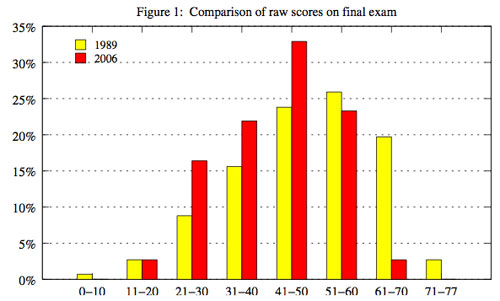
W. Stephen Wilson [75K PDF]:
Professors are constantly asked if their students are better or worse today than in the past. This paper answers that question for one group of students.
For my fall 2006 Calculus I for the Biological and Social Sciences course I administered the same final exam used for the course in the fall of 1989. The SAT mathematics (SATM) scores of the two classes were nearly identical and the classes were approximately the same percentage of the Arts and Sciences freshmen. The 2006 class had significantly lower exam scores.
This is not a traditional research study in mathematics education. The value of this study is probably in the rarity of the data, which compares one generation to another.
….
Nineteen eighty-nine is, in mathematics education, indelibly tied to the National Council of Teachers of Mathematics’ publication, Curriculum and Evaluation Standards for School Mathematics (1989), which downplayed pencil and paper computations and strongly suggested that calculators play an important role in K-12 mathematics education. My 2006 students would have been about two years old at the time of this very influential publication, and it could easily have affected the mathematical education many of them received. Certainly, one possibility is that mathematics preparation is down across the country, thus limiting the pool of well prepared college applicants.
Wilson is a Professor of Mathematics at Johns Hopkins University.
This was an interesting report, to me, in a few respects.
Most immediately, since the course and assessment had remained unchanged it is suggestive that something in the student population changed. It would be interesting to see the mean and standard deviation on the final exam for the intervening years.
From a K-12 perspective, I found the use of SAT Math interesting for two reasons.
Unlike the final exam, the SAT Math has changed over the 1989-2006 period, not just in the re-centering that was mentioned, but also in content coverage. A few years ago, 2004 perhaps, the College Board extended the SAT Math so that it now includes some topics usually associated with Algebra II. That had not previously been the case, although the College Board stated that the new version would not be harder. “Although more advanced math concepts will be added, the difficulty level will not change. For example, an arithmetic question could have a higher level of difficulty than an Algebra II question because of the reasoning skills needed to solve the problem.” So, the SAT the 2006 class took probably assessed somewhat different content and than that administered to the 1989 group.
Because the old SAT only assessed content up through algebra and geometry and the new SAT only extends into algebra II, I found it interesting that there was any surprise that it failed to capture student changes related to success in calculus. A low SAT math score may indicate that a student is poorly positioned for success in calculus, but a high SAT math score is no guarantee of preparation due to the lack of advanced topics and its focus on reasoning skills vs. subject area knowledge.
The SAT subject test Math IIC assesses content that includes some topics typically covered in trig and pre-calc. So, from a standpoint of content coverage, it could be more predictive of student readiness for calculus. However, I believe the Math IIC contains only multiple choice questions and this may limit its rigor and predictive capability. To a degree, the Math IIC is a step toward that more appropriate test that Prof. Wilson desires, although it would not address his concerns about calculator use and is still a multiple choice test. Johns Hopkins is a selective institution and I’m guessing probably already requires SAT applicants to submit some subject tests. Perhaps requiring the IIC specifically should be considered.
Thank you for sharing!